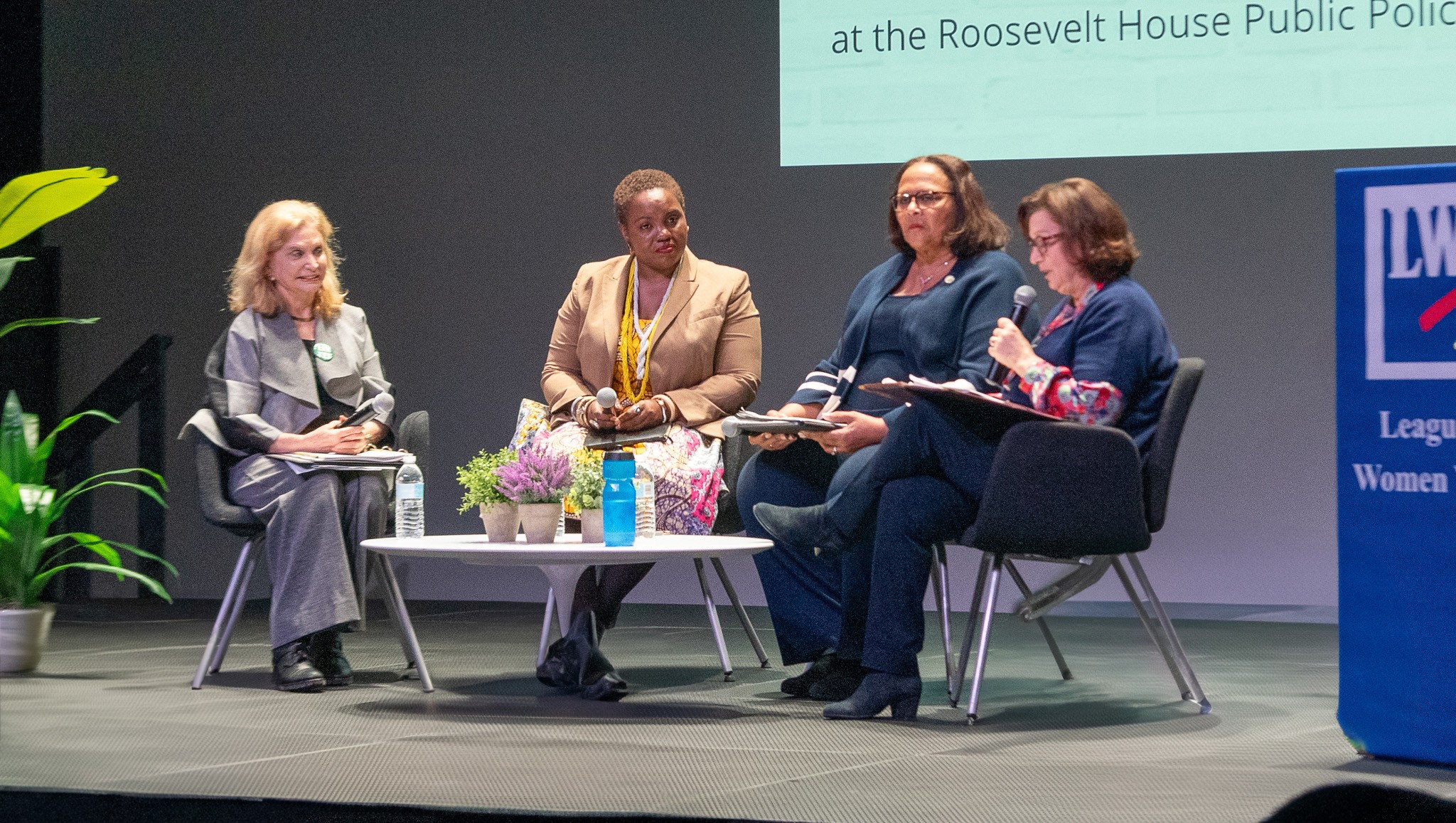East End League of Women Voters Event Promotes NY Equal Rights Amendment

As part of their efforts to persuade Congress to ratify the Equal Rights Amendment nationally, a local chapter of the League of Women Voters held an event urging East End residents to help pass a New York State version of the amendment, which will appear as a referendum on general election ballots this November.
Officially dubbed The New York Equal Protection of Law Amendment, the measure has already been passed by the State Legislature. But it must be approved by voters in order to be officially adopted as an amendment to the state constitution.
According to its supporters, the amendment would greatly expand on protections codified in the state’s 1938 Equal Rights Amendment (ERA), which prohibits discrimination based on race, color, creed or religion – but not sex or gender. Event attendees described the new amendment as much broader, noting that it includes protections against discrimination on the basis of sex, sexual orientation, gender identity or expression, ethnicity, national origin, age, disability, pregnancy, reproductive healthcare and autonomy.
Billed as The Other November Decision, the event was held on March 9 at LTV Studios in Wainscott under the auspices of the League of Women Voters of the Hamptons, Shelter Island and the North Fork. It featured a formidable roster of guest panelists and speakers, headlined by former U.S. Rep. Carolyn Maloney (D-Manhatan), Laura Harding, president of ERASE Racism, a Long Island-based civil rights organization that addresses the impact of ongoing and structural racism, and Margie Bright Matthews, a Democratic South Carolina state senator.
It was moderated by Andrea Gabor, a League of Women Voters board member and Bloomberg Professor of Journalism at Baruch College/CUNY. Speakers included Minerva Perez, executive director of Organización Latino Americana of Eastern Long Island; Rainbow Chavis, an environmental advocate and member of the Shinnecock Nation; and Marissa Velasquez-Rosante, a bay manager specialist for the Town of East Hampton.
Gabor noted that if voters pass the referendum this November, “New York will join 21 other states that currently have a state-level ERA.”
But absent the ratification of a national ERA, the majority of states will continue to operate without full and equal protection of women’s rights under the law.
“There is absolutely no substitute for equal rights being enshrined in the New York State constitution and in the federal constitution,” Maloney said. “The Equal Rights Amendment basically bans discrimination. I can’t think of anything more discriminatory than telling women what to do with their own bodies.”
Many U.S. citizens believe that equal treatment for women is already the law of the land. That is not the case. As several event attendees pointed out, there is nothing in the U.S. Constitution that explicitly protects citizens from discrimination on account of their sex or gender.
In fact, the late Supreme Court Justice Antonin Scalia summed it up very succinctly. “Certainly the Constitution does not require discrimination on the basis of sex,” Scalia said. “The only issue is whether it prohibits it. It doesn’t.”
The national version of the ERA consists in its entirety of one powerful sentence. It says: “Equality of rights under the law shall not be denied or abridged by the United States or any state on account of sex.”
If ratified, its supporters say the amendment would be a monumental step forward in the fight for gender equality in particular and civil rights in general.
According to materials prepared by the organization Sign4ERA.org, a national ERA “would add constitutional protection to the progress we have already made in gender equality… with the ERA, these rights would be universal across all states and could not be randomly reversed by the courts — or the president. It would also allow us to make further legislative progress, such as the enforcement of equal pay for equal work, LGBTQ+ protections, and restoring legal access to abortion and the right to choose.”
The original ERA was first introduced in Congress in 1923, three years after women won the right to vote, by Republican Daniel Anthony of Kansas, the nephew of famed suffragist Susan B. Anthony. It failed in 1923 and continued to fail after being reintroduced in every Congress for almost 50 years.
In 1972, the ERA finally passed the House and Senate with the two-thirds majority needed to enact a constitutional amendment. However, ratification of the amendment by three-quarters of U.S. states is also needed for an amendment to become law. After the measure passed, Congress imposed a deadline of seven years for ratification by the states. That deadline was later extended to 1982. By the end of the deadline period (a time limit which ERA proponents call “entirely arbitrary”), only 35 states had signed on, which was below the 38-state threshold needed for ratification.
Students of political history and those old enough to remember the ’70s know that the groundswell of popular opposition to the ERA ran through one person: Phyllis Schlafly, the conservative activist and anti-feminist crusader. Schlafly almost single-handedly ensured the demise of the ERA at the time by rallying public opinion and lobbying Congress against what she said were the myriad evils of the amendment.
The ERA would continue to languish until 2020, when Virginia became the 38th state to ratify it. Now that three-quarters of the states have committed to ratification, the next step toward adoption for the measure’s supporters is to roll back the deadline imposed by Congress in 1972. The current ratification strategy involves the use of a discharge petition to try to overcome opposition to the measure. Joint resolutions have been introduced in both the House and the Senate that affirm the ERA is already ratified and should become the 28th amendment.
“I can honestly say that we are closer to ratification now than we have ever been in my lifetime,” Maloney said. “And I’ve worked on this issue every year since I’ve been in Congress. We have the same bill in both Houses; We have 53 cosponsors – Republicans and Democrats – in the Senate and we have over 208 bipartisan votes in the House.”
“When something is enshrined in the Constitution, there’s a culture shift,” added ERASE Racism’s Laura Harding. “We don’t talk about the white male patriarchy – and if you live on Long Island you know about the white male patriarchy – and the way it runs rampant. Given the attacks on diversity, equity and inclusion efforts, I think that the ERA is more important now than ever.”
In addition to being more optimistic about the prospects for ratification of the national version of the ERA than she has ever been before, Maloney also said she believes that the New York State ERA referendum is on its way to passage this November.
Harding is not so sure.
“The reality is that the New York State ERA amendment is reflective of the tensions that are happening in this country – culturally, spiritually and racially,” Harding said. She added that among some of her peers and colleagues at Howard, a historically Black university, there was a sense that the act of giving other marginalized groups protections was sometimes seen as eroding the protections that Black people had obtained over the years.
“We know that Black people sometimes feel that they’re being ostracized and pushed to the side as the country browns,“ she said. “People who love the ERA may not love asylum seekers or Latinx migrants. I think we have to educate people and [present this] as our state’s first attempt at really protecting everyone.”



